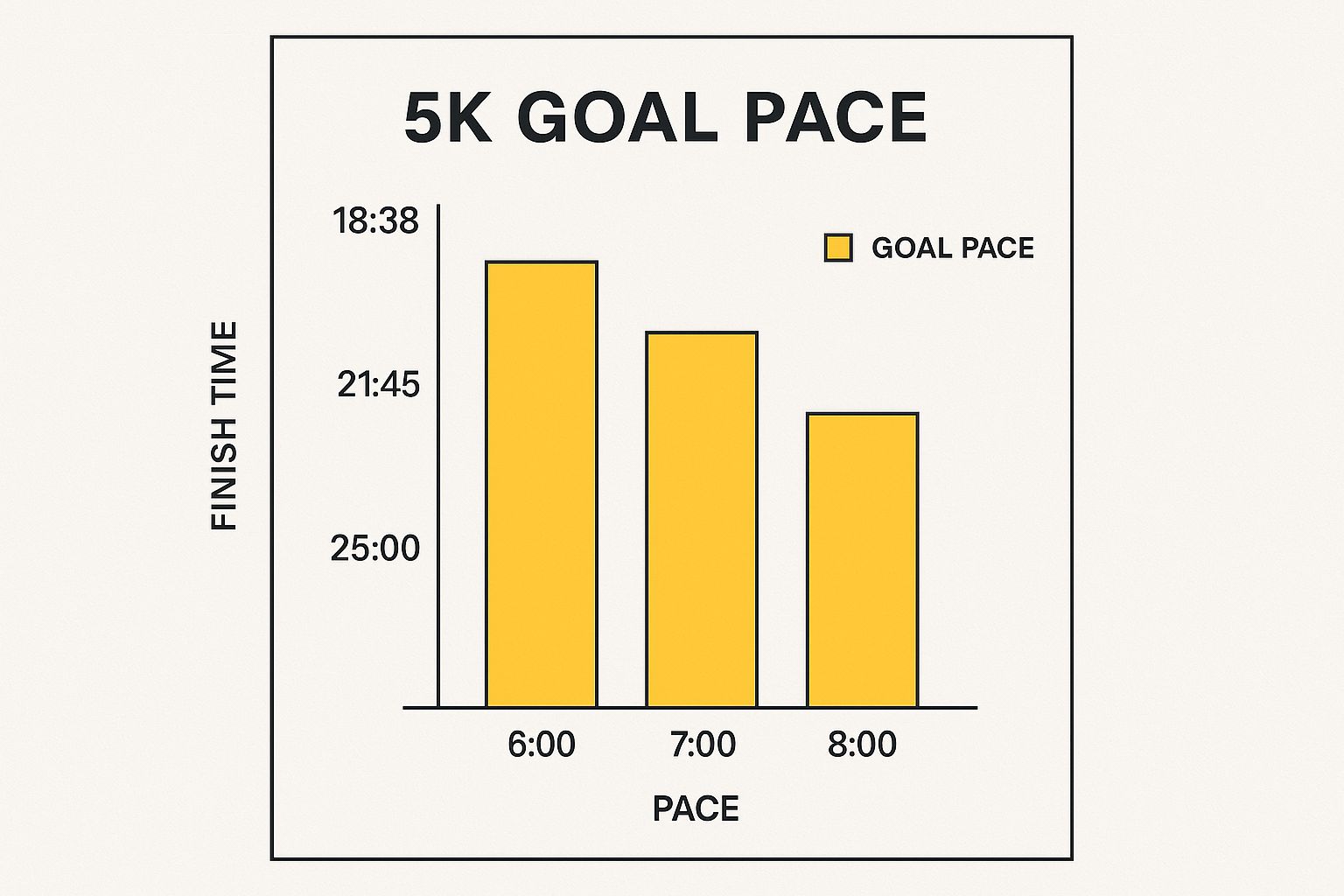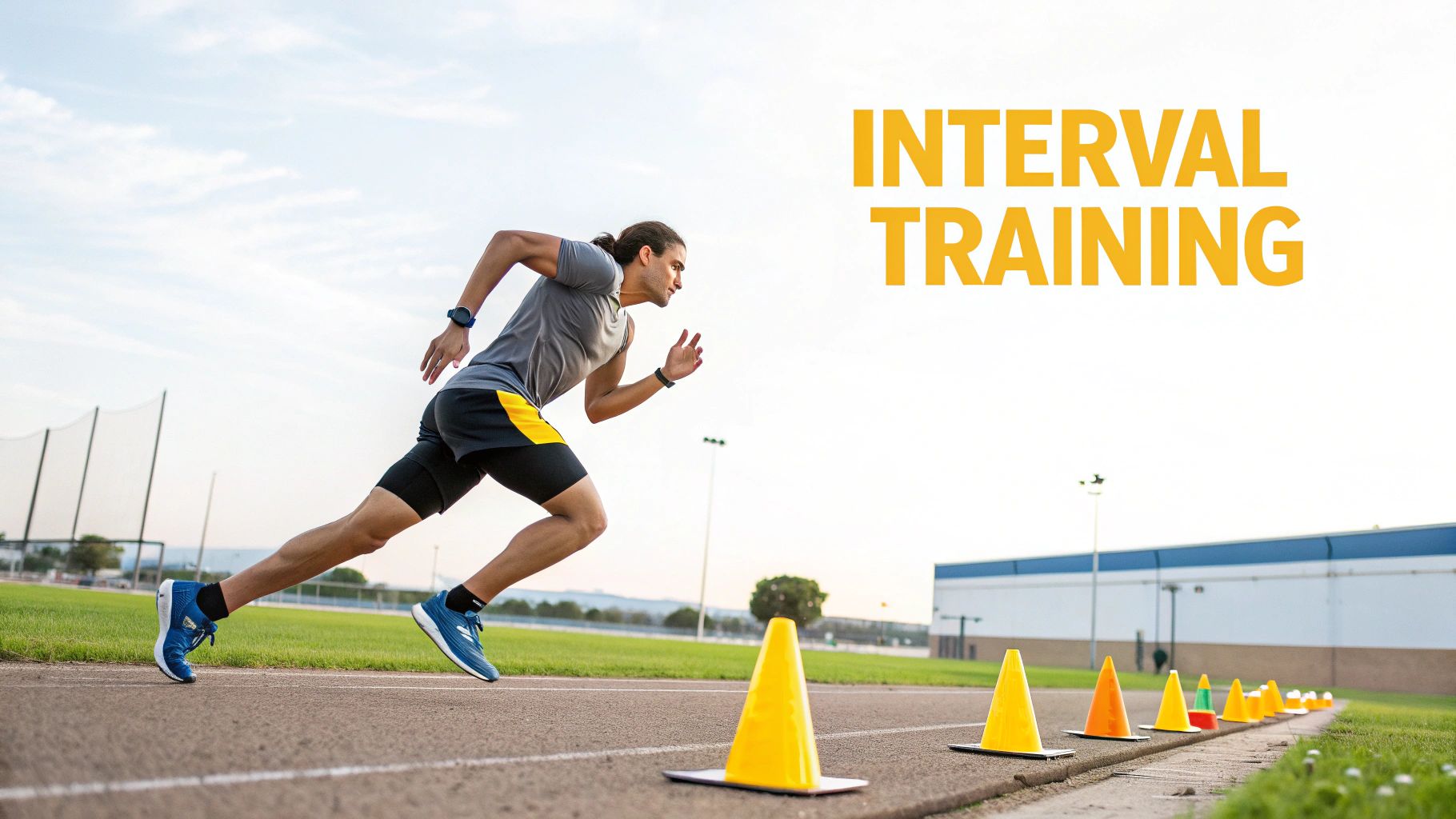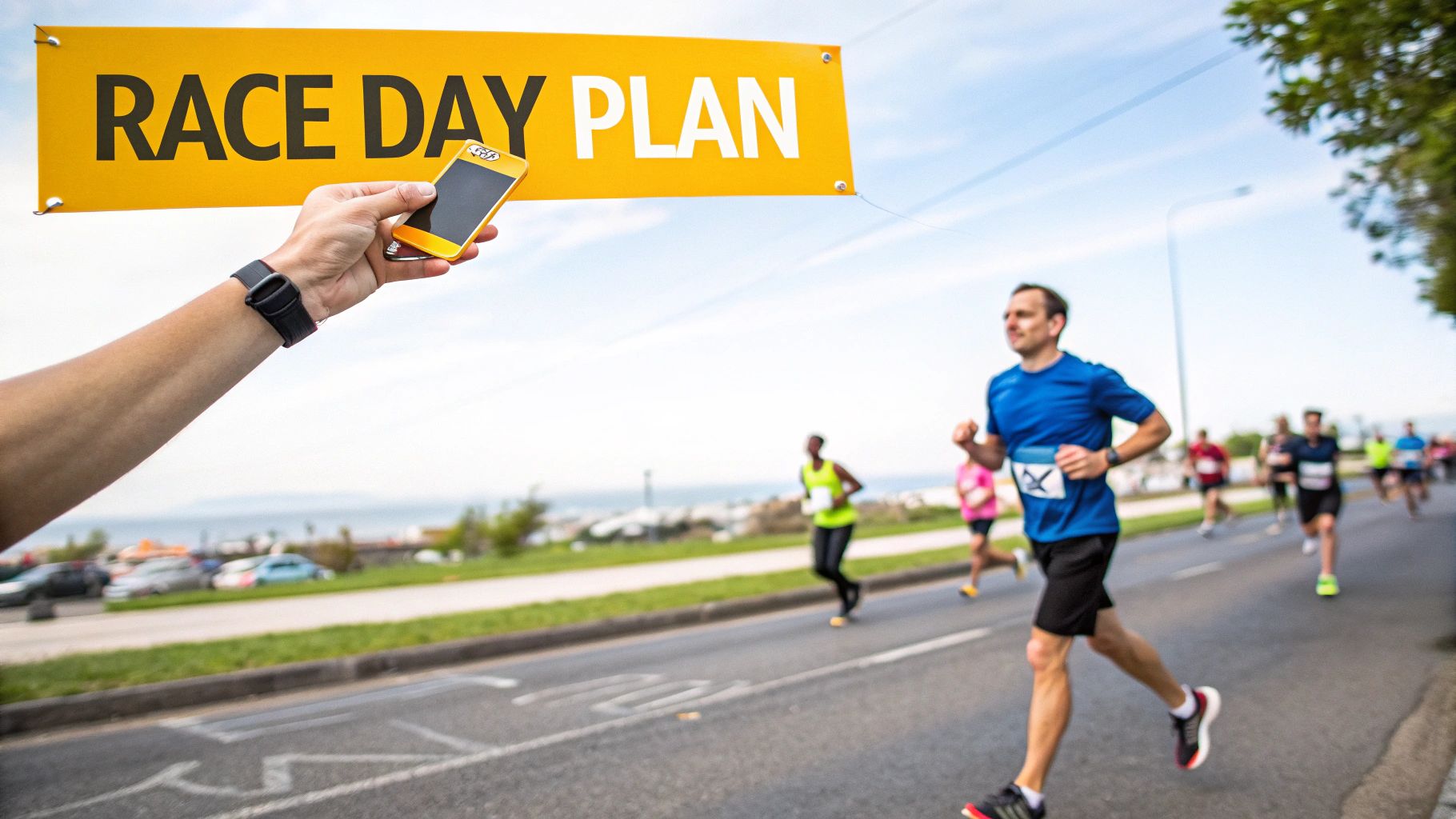Pacing for a 5K: Expert Tips for Race Success
The Science Behind Effective 5K Pacing

Understanding the science behind pacing is key for a successful 5k. This distance presents a unique challenge, engaging both your aerobic and anaerobic systems. Finding the right balance between using oxygen efficiently and pushing your limits without hitting “the wall” is essential.
Starting too fast, for example, can deplete your anaerobic energy reserves, causing a significant slowdown later in the race.
Understanding how your body responds to different effort levels can dramatically improve your performance. Think of your body like a car: maintaining a consistent speed (steady pace) is more fuel-efficient than constant acceleration and deceleration (erratic pacing).
Recognizing physiological warning signs like breathlessness or muscle fatigue early on can also prevent a disappointing finish.
Pacing Strategies for Different Performance Levels
5k pacing isn’t a one-size-fits-all approach. Your strategy depends on your experience and goals. Pacing for a 5K in the UK requires understanding average completion times. The average 5K finish time for all UK runners is 33 minutes.
Men tend to finish faster, averaging 29 minutes, while women average 38 minutes. This difference highlights the importance of individualized pacing. Find more detailed statistics here.
A male runner aiming for the average 29-minute finish would need a pace of roughly 5:48 minutes per kilometer. This is considerably faster than the average female pace of 7:36 minutes per kilometer.
Utilizing Pacing Tools
Thankfully, several tools can help you determine your ideal pace. You might be interested in learning How to master your 5k pace using a calculator . These calculators can translate your target finish time into kilometer splits.
This creates a roadmap for your run, allowing you to monitor your progress and make adjustments throughout the race. This is particularly useful for first-time runners or those striving for a personal best.
Common Pacing Mistakes and How to Avoid Them
One common mistake is starting too fast, fueled by the excitement of race day. This initial burst of speed can lead to early fatigue and a slower overall time.
To avoid this, maintain a consistent pace from the start, even if it feels slower than you’d prefer. This disciplined approach will pay dividends in the later stages of the race, allowing you to conserve energy and finish strong.
How Age and Experience Reshape Your 5K Approach
Age isn’t just a number when it comes to running a 5k; it significantly influences your pacing strategy. Different age groups have varying physiological factors that affect their running performance. Younger runners often have more fast-twitch muscle fibers, enabling quick bursts of speed and potentially more aggressive pacing early on. However, they need to manage their energy to avoid early burnout.
As we age, our bodies change. Recovery capacity and lactate clearance decrease, influencing how we approach a 5k. Older runners might have less raw speed, but often have greater aerobic efficiency, letting them maintain a steady pace over longer distances. This favors a pacing strategy based on consistency and endurance.
Pacing Based on Experience
Experience also plays a vital role. First-time 5k runners may struggle to judge their pace, either starting too fast and fading or starting too slow. The infographic below shows how small pace changes impact your overall time:

As illustrated, a one-minute per mile difference can add over three minutes to your 5k time. When planning your 5k pace, consider your age and experience. For women in the UK, average 5k times vary significantly. For example, women aged 12-27 who are experienced runners average 30 minutes and 17 seconds. First-timers in this age group typically average 35 minutes and 2 seconds. Gen X women (aged 44-59) average 33 minutes and 15 seconds after their first 5k, compared to 38 minutes and 24 seconds for their initial attempt. This shows how pacing improves with practice. For more detailed statistics on average 5k times, visit Women’s Health Magazine UK .
The following table provides a comparison of average 5k finish times across different age and experience levels for UK runners:
Average 5K Times by Age Group and Experience Level
| Age Group | First-Time Runners | Experienced Runners | Improvement |
|---|---|---|---|
| 12-27 | 35:02 | 30:17 | 4:45 |
| 44-59 | 38:24 | 33:15 | 5:09 |
This table clearly demonstrates that with experience, runners in both age groups significantly improve their 5k times, highlighting the importance of pacing strategy and practice. The greater improvement seen in the 44-59 age group suggests the potential benefits of experience and consistent training for older runners.
Age-Specific Pacing Strategies
More experienced runners have a clearer understanding of pacing. They’ve learned from past races, can better judge their effort, and maintain a consistent pace. They avoid using all their energy in the first kilometer and strategically adjust their pace based on feel and remaining distance. This allows them to finish strong and achieve faster times.
Crafting Your Personalized 5K Pacing Blueprint
Generic pacing advice can only take you so far. The real key to success lies in developing a truly individualized strategy. This means taking a systematic approach to determine your optimal pace zones, based on recent training, fitness assessments, and your specific race goals.
Calculating your ideal kilometer splits requires careful consideration of your unique physiological profile and the anticipated race environment. Understanding factors like course elevation and predicted weather conditions on race day is crucial, mirroring how elite coaches fine-tune their athletes’ strategies. Even the surge of race-day adrenaline can influence your pace and should be accounted for in your plan.
Using Technology to Your Advantage
Technology provides invaluable tools for maintaining pace control. GPS watches, for example, offer real-time feedback on your current pace, allowing you to adjust your effort as needed. Garmin is one popular brand offering a wide range of GPS watches. Heart rate monitors provide insights into your exertion level, helping you stay within your target heart rate zone. Using these tools effectively can be the difference between achieving your goal and falling short. You might be interested in: How to master your personalized training programme .
Practical Methods for Calculating Your Splits
There are several practical methods you can use to calculate your ideal kilometer splits. One common approach is basing your calculations on a recent time trial or race performance. For example, if you recently ran a 10k, you can use that time to estimate your 5k potential. Another method involves using online pace calculators, which factor in elements like your age, gender, and recent training data.
Incorporating Course and Weather Conditions
Course elevation and weather can significantly impact your pace. A hilly course demands adjustments to your pacing strategy, with slower paces uphill and faster paces downhill. Similarly, hot and humid conditions can slow you down, necessitating a more conservative initial pace.
Building Your Pacing Blueprint Step-by-Step
- Assess Your Current Fitness: Conduct a time trial or use a recent race performance to establish a baseline.
- Set Realistic Goals: Determine your target 5k finish time based on your current fitness level and training schedule.
- Calculate Your Target Pace: Use a pace calculator or a simple formula to determine your ideal kilometer splits.
- Factor in Course and Weather: Adjust your target pace based on the course elevation and the expected weather conditions.
- Practice Your Pacing: Incorporate pace-specific workouts into your training plan to develop a feel for your target pace.
- Race Day Execution: Use your GPS watch or heart rate monitor to help maintain your target pace throughout the race.
By following these steps, you can create a personalized pacing blueprint that maximizes your 5k performance.

Strategic Pacing for Every Runner Personality Type

Your running personality plays a big role in determining the best 5k pacing strategy for you. This section explores different approaches tailored to various runner profiles. Whether you burst off the starting line or prefer a more measured approach, understanding your tendencies is key to a successful race. Interestingly, a significant portion of the UK population (48%) has never run a 5k. This underscores the importance of accessible pacing strategies for beginners. For experienced runners, the popularity of 5k races, with 28,800 events recorded recently, highlights the demand for effective pacing plans. Explore this topic further.
The Aggressive Starter
Some runners instinctively surge ahead at the start. For these aggressive starters, controlled enthusiasm is vital. Going out too fast can lead to a mid-race energy crash. The goal is to balance initial excitement with a realistic assessment of your fitness level.
- Start Strong, But Controlled: Find a comfortably hard pace for the first kilometer, resisting the urge to sprint.
- Kilometer 2-4: Maintain a consistent effort, paying attention to your form and breathing.
- Final Kilometer: Use any remaining energy for a powerful finish.
The Negative Splitter
Negative splitting is a strategy where you run the second half of the race faster than the first. This approach requires careful planning and disciplined execution throughout the race.
- First Kilometer: Begin conservatively, establishing a steady and manageable pace.
- Kilometer 2-4: Gradually increase your speed, aiming for a slightly faster pace each kilometer.
- Final Kilometer: Push yourself to the limit, striving for your fastest kilometer of the race.
The Run-Walk Strategist
Run-walk intervals can be a particularly effective strategy, especially for those newer to running. This method alternates periods of running with short recovery walks, allowing you to maximize performance and gradually build endurance.
- Determine Your Intervals: Based on your current fitness level, figure out the best run/walk ratio for you (for example, 3 minutes running/1 minute walking).
- Maintain Consistency: Adhere to your chosen intervals throughout the race, avoiding the temptation to deviate from the plan.
- Focus on Effort: During the running portions, maintain a comfortable effort level without pushing too hard.
To help you visualize these different pacing strategies, the table below summarizes the key approaches for each runner type.
5K Pacing Strategies by Runner Type
| Runner Type | First KM Strategy | Mid-Race Approach | Final KM Strategy | Best For |
|---|---|---|---|---|
| Aggressive Starter | Comfortably hard pace | Maintain consistent effort | Unleash remaining energy | Runners who naturally start fast |
| Negative Splitter | Conservative pace | Gradually increase speed | Fastest kilometer of the race | Experienced runners who can pace themselves well |
| Run-Walk Strategist | Predetermined run/walk intervals | Stick to intervals | Maintain consistent effort during runs | Beginners or runners looking to build endurance |
By understanding your running personality and adopting a pacing strategy that complements your natural tendencies, you can significantly enhance your 5k performance. Combining this personalized approach with consistent training and thorough pre-race preparation is a recipe for success on race day.
Training Sessions That Perfect Your 5K Pacing
Exceptional pacing in a 5k doesn’t just happen; it’s the result of dedicated and structured training. This involves workouts designed to fine-tune your internal pacing clock. Think of it like learning a musical instrument: consistent practice is key to mastering a complex piece. Similarly, regular training teaches your body to recognize and maintain specific effort levels, crucial for effective 5k pacing.
Interval Training for Pace Control
Interval training involves alternating high-intensity bursts with recovery periods. These sessions are highly effective for developing pace awareness. For example, a workout might include 800-meter repeats at your target 5k pace, followed by 400-meter recovery jogs. This helps your body learn what your goal pace feels like and improves your ability to sustain it.
Threshold Runs for Lactate Tolerance
Threshold runs are performed at a “comfortably hard” pace, just below your lactate threshold, the point where lactic acid starts building up in your muscles. Regular threshold runs enhance your body’s ability to clear lactate, letting you maintain a faster pace for a longer time. A typical threshold run could be a 20-minute continuous run at this challenging pace.
Race Simulation Workouts
As your 5k approaches, race simulations become essential. These workouts replicate the demands of race day, preparing you both physically and mentally. A race simulation might involve running the entire 5k distance at your target pace or breaking it down into segments with short recovery periods.
Structuring Your Training Week
The sequence of these training sessions throughout your week is vital for maximizing their impact. Effective coaches meticulously plan each workout, balancing intensity and recovery. A typical week could include two interval sessions, one threshold run, one race simulation, and easier runs for active recovery. Check out our guide on calculating your training zones to further refine your training plan. This structured approach builds pacing intelligence without risking injury or pre-race burnout.
Pace Targets, Recovery, and Progression
Each workout should have defined pace targets, recovery protocols, and progression pathways for varying abilities. This allows you to gradually increase workout intensity and duration as you get fitter. Much like a builder needs a blueprint, your training requires a structured plan with clear goals and progression steps. This ensures consistent challenges while staying within safe limits. For example, you might progressively increase the distance of your threshold runs or the number of intervals over time. This methodical approach builds a solid foundation for race-day success.
Race Day Execution: From Strategy to 5K Success
The culmination of your 5k training plan arrives on race day. This section bridges the gap between your preparation and performance, offering practical guidance for executing your strategy, even amidst the race-day excitement.
Pre-Race Warm-Up and Mental Preparation
Your warm-up should be a consistent routine, both physically and mentally. This might involve a light jog and dynamic stretches, focusing on the muscles you’ll use during the race. Visualizing your race, including pacing and navigating the course, is equally crucial for mental preparedness.
The First Kilometer: Managing the Initial Surge
The initial excitement can tempt you to start too fast. Managing this early burst of energy and sticking to your planned pace is vital. A controlled start sets you up for a stronger finish. Think of it like pacing yourself on a long drive—you wouldn’t burn all your fuel right away.
The Middle Kilometers: Maintaining Focus and Pace
Mental toughness is key in the middle kilometers. As fatigue sets in, maintaining focus and pace becomes challenging. Use course markers to break the race into smaller, more manageable sections. Focusing on a competitor slightly ahead can provide motivation and help maintain your target pace.
The Final Kilometer: Unleashing Your Finishing Kick
The final kilometer is your time to shine. Draw on your training and push through any remaining fatigue for a strong finish. Visualize the finish line and unleash your final sprint. For more training advice, you might be interested in this article: How to master HYROX with a structured training plan.
Post-Race Analysis: Learning and Improving
Post-race reflection is crucial for improvement. Analyze your performance: Did you maintain your planned pace? Where did you struggle? What could you have done differently? This analysis offers valuable insights for future races.
Expert runners use external cues like course markers and competitors, along with internal feedback like breathing and perceived exertion, to maintain optimal pacing. By integrating these strategies, you can turn your pacing plan into a successful race. Ready to elevate your training? Kracey offers personalized plans tailored to your needs and goals, helping you reach peak performance. Visit Kracey today.
Table of Contents
- The Science Behind Effective 5K Pacing
- Pacing Strategies for Different Performance Levels
- Utilizing Pacing Tools
- Common Pacing Mistakes and How to Avoid Them
- How Age and Experience Reshape Your 5K Approach
- Pacing Based on Experience
- Age-Specific Pacing Strategies
- Crafting Your Personalized 5K Pacing Blueprint
- Using Technology to Your Advantage
- Practical Methods for Calculating Your Splits
- Incorporating Course and Weather Conditions
- Building Your Pacing Blueprint Step-by-Step
- Strategic Pacing for Every Runner Personality Type
- The Aggressive Starter
- The Negative Splitter
- The Run-Walk Strategist
- Training Sessions That Perfect Your 5K Pacing
- Interval Training for Pace Control
- Threshold Runs for Lactate Tolerance
- Race Simulation Workouts
- Structuring Your Training Week
- Pace Targets, Recovery, and Progression
- Race Day Execution: From Strategy to 5K Success
- Pre-Race Warm-Up and Mental Preparation
- The First Kilometer: Managing the Initial Surge
- The Middle Kilometers: Maintaining Focus and Pace
- The Final Kilometer: Unleashing Your Finishing Kick
- Post-Race Analysis: Learning and Improving